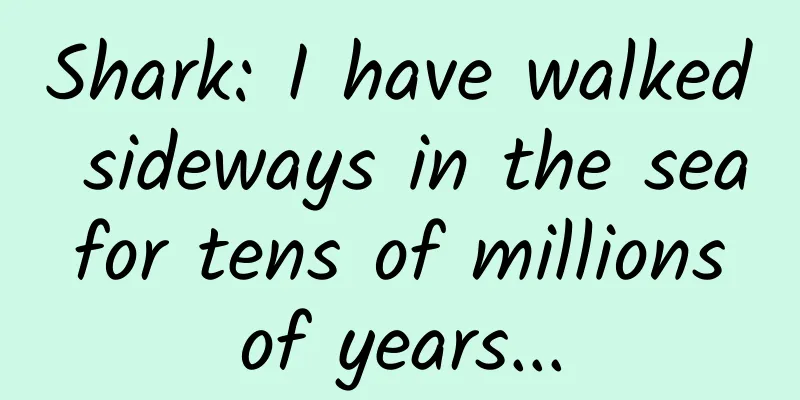Shark: I have walked sideways in the sea for tens of millions of years...

|
Author: Lin Xianghong Thanks to Spielberg's masterpiece "Jaws", when we mention sharks, we often think of a figure that is agile and powerful, shuttling back and forth underwater, and a terrifying bloody mouth. Of course, there are indeed certain stereotypes, because most species of sharks are relatively gentle and will not hurt people. You should know that there are more than 530 species of sharks in the world, and only a dozen of them have a record of hurting people. For example, the whale shark, the largest living fish, can reach a length of more than 10 meters. Although it is very large, it filters food such as algae, krill, and small fish, which is completely different from the fierce and majestic image of sharks in our impression. However, as the saying goes, "Good news doesn't travel far, but bad news travels a thousand miles." Because these few terrifying sharks, represented by the great white shark, have left us with an overly shocking impression, we often overlook the gentle image of most other sharks. The famous novelist Hemingway once described the brutality of sharks in his novel "The Old Man and the Sea": "These sharks only have thick, sharp blue heads, huge eyes, and snapping, all-devouring aggressive mouths. When they are hungry, they will not even let go of the oars or rudders on the boat. They will bite off the feet and fin-like limbs of turtles when they are asleep on the water; if they are really hungry, they will even attack people in the water, even though people do not have the smell of fish blood or fish mucus. They are killers who do all kinds of evil." The huge and ferocious Megalodon in the movie "The Meg" released in recent years has raised our impression of shark horror to a new level. Such a prehistoric giant shark, which was thought to have disappeared for a long time, suddenly appeared in front of the world like a nightmare and started a killing spree. The shock it brought can be imagined. However, the giant shark in "The Meg" is not completely fictional. Such sharks did exist in prehistoric times, and its teeth are 15-16 cm in size. In fact, the sharks we are talking about now refer to most members of the class Chondrichthyes in a broad sense, but in a narrow sense, they only refer to the new sharks in the subclass Elasmobranchs of cartilaginous fish. The class Chondrichthyes to which sharks belong has a very long evolutionary history. They were born from ancient placoderms more than 400 million years ago and parted ways with our ancestors more than 400 million years ago. The earliest cartilaginous fish appeared in the Early Silurian period more than 400 million years ago - Fanjingshan fish and Diplodocus of the class Acanthopterygii. It was not until the Devonian period that the slit-mouthed sharks with a more advanced ecological niche appeared. However, cartilaginous fishes were not large in size during this period and basically lived under the shadow of sea scorpions or terrestrial fishes. This can be reflected in the size, distribution and number of their fossils. Then 290 million years ago, a group of ferocious "sea monsters" appeared on the earth, swimming in the vast oceans around the world. The most representative of them were the lobate-toothed shark and the spiral-toothed shark. In the Triassic to Jurassic period, the true sharks in the subclass of the elasmobranch really rose. The pioneer of the true sharks, the bow shark, showed its prowess in the Triassic ocean. They are widely distributed. In addition to saltwater oceans, they even spread their footprints to inland freshwater lakes to prey on smaller animals in those waters. By the Cretaceous period, we can already see tiger sharks, wobbegongs, flat sharks, cat sharks, and other real sharks that can still exist in our oceans. At this time, there are two outstanding representatives among sharks, namely the Cretaceous sharpnose shark and the horn-scaled shark. The former may be similar to our great white shark today, and the latter is similar to today's tiger shark. We can see tooth fossils embedded by horn-scaled sharks in many scattered animal bone fossils in the Cretaceous strata. In the Cenozoic Era, the megalodon shark, which we are familiar with in movies, appeared out of nowhere and became the undisputed overlord of the oceans in the Tertiary Period. This prehistoric giant shark, with an average length of 14 meters (as high as a 4-5-story building when hung up), and a maximum bite force estimated to be 20 tons, may be one of the creatures with the strongest bite force ever discovered in the history of the earth. In front of it, whales, giant squids and other marine creatures that are already heavy enough seem vulnerable. People have been studying this shark for nearly 400 years. In recent years, some new technologies and methods used by paleontologists have further confirmed the megalodon's dominance. In a cover article published in Science Advances this year, titled Cenozoic megatooth sharks occupied extremely high trophic positions, paleontologist Kast used the stable isotope method and the correspondence between the nitrogen-15 isotope content in the enamel and dentin of modern marine animals and their position in the food chain (that is, the higher the nitrogen-15 ratio in the teeth, the more nutrients the organism has consumed and the higher its level in the food chain). He found that the nitrogen-15 ratio in megalodon tooth enamel was much higher than that of modern great white sharks, polar bears, and killer whales, indicating that the megalodon's nutritional level was very high and it was indeed at the top of the entire food chain at the time. In another journal published this year in Science Advances, paleontologist Jack Cooper combined the three-dimensional data of the spine and teeth of the ear-shaped megalodon with the soft skull reconstruction of the living great white shark to calculate a complete megalodon model. The calculated results show that the ear-shaped megalodon was more than 15 meters long and weighed up to 6,156 kilograms. It also swam faster and had the ability to cross the ocean and actively prey on large prey. However, the fate of cartilaginous fish was very unfortunate. It took them 400 million years to let the megalodon take the throne of the ocean overlord, but this prosperity did not last long. The megalodon lived on the earth for 20 million years, but suddenly became extinct in the Pleistocene 2 million years ago, which was probably closely related to the sudden cooling of the climate. Although this is misfortune for the shark, it is also luck for us humans to a certain extent. Imagine if there are such monsters in the sea, then the horrific plot in the movie "The Meg" might really become a reality. References [1]Andreev, PS, Sansom, IJ, Li, Q. et al. Spiny chondrichthyan from the lower Silurian of South China. Nature 609, 969–974 (2022). https://doi.org/10.1038/s41586-022-05233-8 [2] Nicholas D. Pyenson,Paul L. Koch,Oh, the shark has such teeth: Did megatooth sharks play a larger role in prehistoric food webs?, Science Advances, 8, 25, (2022). [3] Cooper JA, Hutchinson JR, Bernvi DC, Cliff G, Wilson RP, Dicken ML, Menzel J, Wroe S, Pirlo J, Pimiento C. The extinct shark Otodus megalodon was a transoceanic superpredator: Inferences from 3D modeling. Sci Adv. 2022 [4] Kenshu Shimada, Martin A. Becker & Michael L. Griffiths (2021) Body, jaw, and dentition lengths of macrophagous lamniform sharks, and body size evolution in Lamniformes with special reference to 'off-the-scale' gigantism of the megatooth shark, Otodus megalodon, Historical Biology, 33:11, 2543-2559, DOI: 10.1080/08912963.2020.1812598 The article is produced by Science Popularization China-Starry Sky Project (Creation and Cultivation). Please indicate the source when reprinting. |
>>: Stop stepping on the toilet seat! Your toilet seat may be dirtier than the public toilet!
Recommend
People's Daily criticized Apple iPhone by name: Why is a mobile phone brand that ranks only fifth in domestic sales so arrogant?
As the iPhone throttling incident ferments around...
Android M full name Android Marshmallow
Last week, Google released a promotional video fo...
How did Momo gain tens of millions of users in just one year?
In June 2011, Boss Wang (Wang Li called himself B...
Zhihu, Toutiao, NetEase Cloud Music, 21 marketing details that still have dividends
As WeChat and Weibo operations become increasingl...
Building a bridge for blood: Breakthrough progress in the development of small-caliber artificial blood vessels
As people's living standards improve, unhealt...
Is the Laniakea Supercluster, composed of 100,000 galaxies, the largest structure in the universe?
What is the world to a person? Is it the Earth? N...
Download the Beiyu Academy "Narrative Writing (Level 2): Writing Materials" from Baidu Cloud
Beiyu Academy's "Narrative Writing (Leve...
How does Zhihu continue to accurately direct traffic to private domains?
More and more people in the market are beginning ...
10 Observations on E-commerce Marketing in 2020
This article, which contains 10 observations for ...
The black box has been found! All aircraft are required to install it. What important information can it provide?
The crash of China Eastern Airlines flight MU5735...
Dopamine VS endorphins, which one brings true happiness?
If you are also a heavy patient of short videos, ...
Office software Excel/Word/PPT zero-based intensive course
Learn to master: Acquire a complete office knowle...
Surprise! It turns out that the plasticine we played with as children was actually used to build tanks
Did you know that science is full of happy accide...
Behind the skyrocketing memory prices is an endless war you can’t see
On February 3, 2012, Steve Appleton, CEO of Micro...
Short video promotion skills in the home improvement industry, with successful cases!
Advertising is the first impression that consumer...









